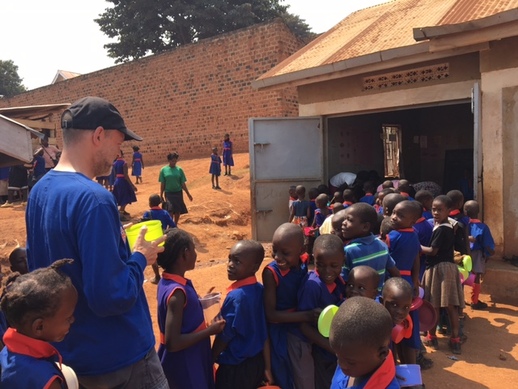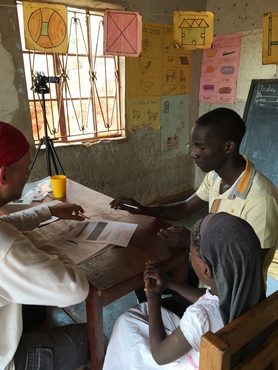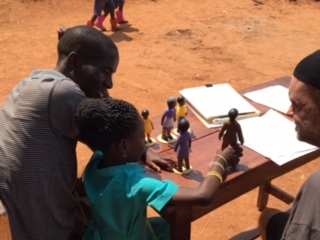Research Interests
The conceptual relations between psychoanalytic theory and attachment theory; social and emotional development of high and low-risk infants and children; mother-infant and mother-child interactional processes and clinical and developmental outcomes; etiology, development, transmission, and prevention of psychopathology associated with the mother-child attachment relationship and implications for clinical intervention and public policy; program and policy evaluation based on clinical and developmental perspectives; psychological risks associated with foster care and poverty; development of gender and cultural differences; child and adult psychotherapy process and attachment; quantitatively based methods of assessing supervisee competence; sex addiction and attachment; maternal literacy and young children’s school readiness skills and literacy acquisition; theoretical, philosophical, political, moral, and religious issues in clinical and developmental psychology.
GRANTS AWARDED
PRINCIPAL INVESTIGATOR: “Testing the Therapeutic Effectiveness of Two Group Intervention Programs on Private Middle School Students.” The purpose of this four- year research study is to test the effectiveness of two weekly, 60-min group interventions taking place as part of the ongoing curriculum at De La Salle Academy, a private middle school in Manhattan. In September, approximately 30 11 to 13-year-old students (grades 7 and 8) decided to participate in a year-long curriculum-based group intervention program (eight members per group) led by group leaders who are supervised by Carla Rentrop, Ph.D., Site Supervisor. Dr. Rentrop is supervising the group leaders throughout the school year (2 per group). Students were randomly assigned to either 1) the Storytelling/Story-Acting (STSA) activity or 2) the Mentalization-Based Therapy group intervention (MBT-G) with adolescents. Two kinds of measures are being administered to assess the students’ progress: 1) baseline, midpoint, and termination measures, administered in September (prior to the first group session), January, and May (after the final group session); and 2) group process measures, administered at the end of each group session. The first set of measures will determine each group intervention’s therapeutic effectiveness; the second set of measures will determine the trajectory of the group process as well as the weekly progress made by the students throughout the school year. In addition, we are reviewing grade reports from the school as a supplemental
PRINCIPAL INVESTIGATOR: “A Randomized Controlled Trial of the Storytelling/Story-Acting Activity: Its Impact on Ugandan Preschool Children’s Emergent Literacy Skills and Social Competence”. Researchers traveled to two rural villages in Uganda to conduct a research study designed to assess the impact of a Storytelling/Story-Acting activity (STSA) on preschool children’s emergent literacy skills and social competence (N = 123). One group of children (n = 62) are participating in STSA twice per week for one year at the Mpigi Community Library and Kabubbu Community Library. The STSA protocol was developed by Vivian Paley (1990) to enhance development in emergent literacy and social competence. I am comparing these participating children with a second group of children (n = 61) from the same two villages who are not participating in the STSA activity. All children from both villages were randomly assigned to these two groups to determine the impact of the STSA activity on these children. In August, 2014, we returned to these villages to collect post- intervention data on both groups of children. We are testing the following hypotheses:
1) Children who participate in STSA twice per week will have higher scores in emergent literacy and social competence than nonparticipating children in both Mpigi and Kabubbu; and 2) primary caregiver reading/literacy habits, cumulative social/contextual risk, primary caregiver sensitivity relating to the child, quality of primary caregiver health, and the child’s quality of attachment to the primary caregiver will moderate the effect of group placement (STSA participation vs. nonparticipation) on the selected outcomes. All 123 children were interviewed prior to initiating STSA in January, 2014, and interviewed again after six months of STSA in August, 2014, to evaluate changes in their emergent literacy and social competence outcomes. Funding for this study is supported by an extramural grant from the J. William Fulbright Foreign Scholarship Board (2014) and two intramural grants from Long Island University (2013-14, 2016-17).
PRINCIPAL INVESTIGATOR: “Evaluating the Effectiveness of a Storytelling/Story-Acting Activity on Ugandan Preschool Children’s School Readiness.” Researchers traveled to rural Uganda to conduct a research study designed to evaluate the effectiveness of a storytelling/story-acting activity (STSA) on preschool children’s school readiness (N =79). One group of children (n = 28) are participating in STSA twice per week for one year at the Kitengesa Community Library located in a small village in rural Uganda. The STSA protocol was developed by Vivian Paley (1990) to enhance development in three key domains of school readiness: 1) emergent literacy, 2) narrative comprehension, and 3) social competence. The participating children are being compared with two groups of nonparticipating same-aged children. One group of nonparticipating children was recruited from Kitengesa (n =30) and has access to the library, while a second group of nonparticipating children was recruited from Ggulama (n = 21), a village with no library access. Both comparison groups are necessary to determine STSA’s impact on the participating children. In 2012, we expect to return to Kitengesa and Ggulama, Uganda, to conduct the same evaluation on all three groups of children—STSA participants and two groups of nonparticipants. We are testing the following hypotheses. 1) Children who participate in STSA twice per week for one year will have higher scores in three domains of school readiness (emergent literacy, narrative comprehension, and social competence) than nonparticipating children in both Kitengesa and Ggulama; and 2) primary caregiver reading/literacy habits, cumulative social/contextual risk, primary caregiver sensitivity relating to the child, quality of primary caregiver health, and the child’s quality of attachment to the primary caregiver will moderate the effect of group placement (Kitengesa STSA participation, Kitengesa nonparticipation, Ggulama nonparticipation) on school readiness outcomes. All 79 children were interviewed prior to initiating STSA in August, 2011, and will be interviewed again after one year of STSA in August, 2012, to evaluate changes in their school readiness outcomes. Intramural funding for this study is being sought from Long Island University.
To learn more about my Uganda research, please visit http://www.rurallibrariesresearchnetwork.net.
To view the YouTube video of the 2012 presentation, click below.
(The podcast and PowerPoint are from a presentation at the Long Island University's Clinical Psychology Doctoral program Applied Child concentration meeting, March 1, 2012.)
To view an 21-minute documentary that my student Eric Yellin made of our Uganda research experiences in 2011 and 2012, click below.
To view a 3-minute documentary on the caregivers' perspectives on the presence of a library in their village, click below.
PRINCIPAL INVESTIGATOR: "The Intergenerational Impact of a Rural Community Library on Young Children’s Learning Readiness Skills in a Ugandan Village." Researchers traveled to rural Uganda to conduct a research study designed to test an intergenerational model of the mediational and moderational pathways of caregiver library usage on children’s learning readiness following the establishment of a rural village library. Fifty-one caregivers and their young children ages 5-7 participated. Caregivers and children were selected from two rural villages: one with library access and one without library access. Each caregiver was interviewed about her library usage, reading frequency to her child, and indices of social-contextual risk, while each child completed a set of selected instruments collectively designed to measure learning readiness as well as a story-completion task with a family of dolls designed to measure attachment quality. Both library access and caregivers’ self-reported quality of medical health independently predicted children’s pictorial curiosity, one measure of learning readiness. We are in the process of coding the children’s responses to the Attachment Story-Completion Task because we are hypothesizing that children’s attachment quality moderates the effect of their caregivers’ self-reported health quality on the children’s learning readiness. We want to continue research on library and literacy impact and use these findings to support the creation of more village libraries across Africa. Funding for this study is supported by an extramural grant from the International Psychoanalytical Association (2010-11).
(The podcast and Powerpoint are from a presentation at the Long Island University's Clinical Psychology Doctoral program applied child meeting, November 12, 2009.)
PRINCIPAL INVESTIGATOR: “Patterns of Attachment Across the Lifespan”. Data collected for the Sears, Maccoby, and Levin (1951-57) longitudinal study and for subsequent follow-up studies, archived at the Henry A. Murray Research Center of Radcliffe College, provide a unique opportunity to study a longitudinal sample using psychological constructs conceptualized since the time of the original study. The wide variety of assessment instruments administered to the participants over many years allows investigators to answer questions of both practical and theoretical significance. The proposed study addresses both levels of inquiry by exploring two issues: (1) relations between mothers' internal working models of their children derived from attachment theory, and a theoretically similar construct (maternal object representations) derived from object relations theory, and (2) relations between these maternal internal working models and object representations and their children's internal working models and object representations assessed in middle adulthood. Funding for this study is supported by two extramural grants from the Radcliffe Research Support Program, Harvard University (1993-94, 1994-95).
PRINCIPAL INVESTIGATOR: “Attachment Disorganization and Internalizing and Externalizing Behaviors in Prepubertal Psychiatric Inpatients and Nonpatients”. A cross-sectional study was conducted on 45 prepubertal psychiatric inpatients ages 5 to 12 and 56 comparison children from a nearby public elementary school. The children were administered the Attachment Story-Completion Task to determine the quality of internal working models of attachment in a seriously emotionally disturbed population. The mothers were also administered the Adult Attachment Interview to determine the quality of their internal working models, as well as other instruments that assessed internalizing and externalizing behaviors in their children. This study addresses three clinically and developmentally relevant issues: (1) patterns of attachment in prepubertal psychiatric inpatients who manifest severe internalizing and externalizing behaviors (two common precipitants of hospital admission), (2) relations between maternal and child internal working models of attachment, and (3) relations between child internal working models and severe internalizing and externalizing behaviors. Attachment research has the potential to increase our understanding of the etiology, treatment, and ultimate prevention of violence directed against the self and violence directed against others in this young, largely overlooked population through the identification of predominant attachment patterns associated with these two types of violence. Funding for this study is supported by five extramural grants from the International Psychoanalytical Association (1999-04), an extramural grant from the Psychoanalytic Training Institute of the New York Freudian Society (1999-00), and four intramural grants from Long Island University (1999-03).
STUDENTS ARE NEEDED FOR THIS PROJECT: Students are needed to transcribe Adult Attachment Interviews. The data can be used for dissertations.
STUDENTS ARE NEEDED FOR THIS PROJECT: Students are needed to transcribe Adult Attachment Interviews. The data can be used for dissertations.
PRINCIPAL INVESTIGATOR: “The Socioemotional Impact of Maternal Migration on the Attachment Patterns of Jamaican Children as Adults”. In this retrospective case-control study, 60 Jamaican students enrolled at the University of the West Indies (UWI) will be recruited and interviewed regarding their experiences of early maternal separations between the ages of 6 and 48 months. Students will be assigned to two groups: students who experienced a minimum six-month maternal migration (e.g., to the United States or England) during early childhood and students who experienced no such maternal migrations. Students will then be administered the Adult Attachment Projective to assess the quality of their attachment patterns. This study is designed to test two hypotheses: 1) that after controlling for stressful life events and other group differences, Jamaican students who experienced a maternal migration during early childhood will be more likely to have an unresolved attachment pattern than the students who experienced no such maternal migrations, and 2) that unresolved attachment will moderate the association between maternal migration and depressive symptoms as measured by the Symptom Checklist-90-Revised (SCL-90-R). Conclusions drawn from this study could be used to promote public awareness of the potential adverse consequences of maternal migration on young children’s socioemotional development. A faculty contact in the Department of Psychology at UWI will facilitate subject recruitment and data collection. Funding for this study is supported by two intramural grants from Long Island University (2005-07).
STUDENTS ARE NEEDED FOR THIS PROJECT: Students are needed to transcribe Adult Attachment Projectives. The data can be used for dissertations.
STUDENTS ARE NEEDED FOR THIS PROJECT: Students are needed to transcribe Adult Attachment Projectives. The data can be used for dissertations.
PRINCIPAL INVESTIGATOR: “Psychotherapy Process and Symptom Outcome in Inpatients with Borderline Personality Disorder”. Dr. Goodman is using the Psychotherapy Process Q-Set (Jones, 2000) to code 127 psychotherapy sessions of five psychiatric inpatients diagnosed with borderline personality disorder. These patients participated in psychodynamic psychotherapy three times per week over a six-month period and were administered a battery of symptom and personality measures at admission (The Fund for Psychoanalytic Research, American Psychoanalytic Association, previously awarded a grant to cover the costs associated with data collection and session transcription to James W. Hull, Ph.D., John F. Clarkin, Ph.D., and Frank E. Yeomans, M.D., Ph.D.). Patients’ final sessions of each week were audiotaped and transcribed. Patients also completed the Symptom Checklist-90-Revised (SCL-90-R; Derogatis, 1983) on a weekly basis from admission to discharge, which yields a Global Symptom Index (GSI) score. First, each of these Q-sorted sessions will be correlated with each of three prototypical Q-sorts, which will yield three adherence correlations associated with each session—a TFP adherence correlation, an MBT adherence correlation, and a DBT adherence correlation. The resulting adherence correlation scores will be correlated with the weekly SCL-90-R GSI scores to determine which of the three sets of scores produced the most global symptomatic change among each of the five patients. Second, a P-technique (Luborsky, 1953, 1995) factor analysis will be conducted on the 127 session Q-sorts that will yield common process factors associated with these five treatments. The resulting process factor scores associated with each session will also be correlated with the weekly GSI scores to determine which process factors are most closely associated with global symptomatic change among each of the five patients. Third, a growth-curve analysis of these five patients’ treatment course will be conducted with the mean weekly GSI scores as the dependent variable to determine how global symptoms reported by borderline inpatients change as a function of the adherence scores and process-factor scores. Borderline diagnostic covariates such as identity diffusion, affect dysregulation, and impulsivity (Clarkin, Hull, & Hurt, 1993) will also be added to the growth-curve analysis to determine whether this information significantly improves the fit of the curve over and above the adherence and process-factor information. Dr. Goodman and his colleagues have already published a growth-curve analysis of treatment response in borderline inpatients as a function of specific diagnostic features (Goodman, Hull, Clarkin, & Yeomans, 1998). Funding for this study is supported by an extramural grant from the International Psychoanalytical Association (2006-07).
STUDENTS ARE NEEDED FOR THIS PROJECT: Students are needed to code psychotherapy transcripts using the Psychotherapy Process Q-Set. The data can be used for dissertations.
STUDENTS ARE NEEDED FOR THIS PROJECT: Students are needed to code psychotherapy transcripts using the Psychotherapy Process Q-Set. The data can be used for dissertations.
CO-INVESTIGATOR: “Using Video Feedback To Enhance Mother-Infant Interaction Between Mothers and Their Infants in Foster Care”. The aims of this treatment-outcome pilot study are to enhance mother-infant communication, which has been associated with children’s socioemotional and behavioral outcomes, and to prevent readmission to foster care. Twenty mothers whose infants (2-36 months) have been placed in foster care within six weeks will be randomly assigned to two groups: a six-session dyadic treatment group and an age-matched no-treatment group. Dyadic treatment will consist of a 10-minute, videotaped free-play session followed by a 45-minute review of the videotape between the mother and a trained therapist. The therapist will facilitate the mother’s commentary on her observations of the dyadic interaction and the meanings of the infant’s behaviors and patterns of communication. Prior to the intervention, all mothers will receive a battery of assessment instruments, including the Adult Attachment Interview (assessing the quality of the mothers’ internal working models) and the NCAST Teaching Scale (assessing the quality of the mother-infant interaction). All mothers will also receive the NCAST Teaching Scale following the sixth session to determine treatment efficacy. This study is designed to test two hypotheses: 1) that video feedback enhances mother-infant interaction in six sessions and 2) that mothers with organized internal working models are more likely to benefit from this intervention than mothers with unresolved internal working models. IRB approval has been granted by both Long Island University and the Administration for Children’s Services. Funding for this study is supported by an extramural grant from the International Psychoanalytical Association (2005-06).
CLINICIAN AWARD: This extramural grant was awarded by the Association for Child Psychoanalysis to treat a financially disadvantaged child in four-times-per-week psychoanalysis (2003-04).
CLINICIAN AWARD: This extramural grant was awarded by the Association for Child Psychoanalysis to treat a financially disadvantaged child in four-times-per-week psychoanalysis (2003-04).
Copyright © 2018 Dr. Geoff Goodman


